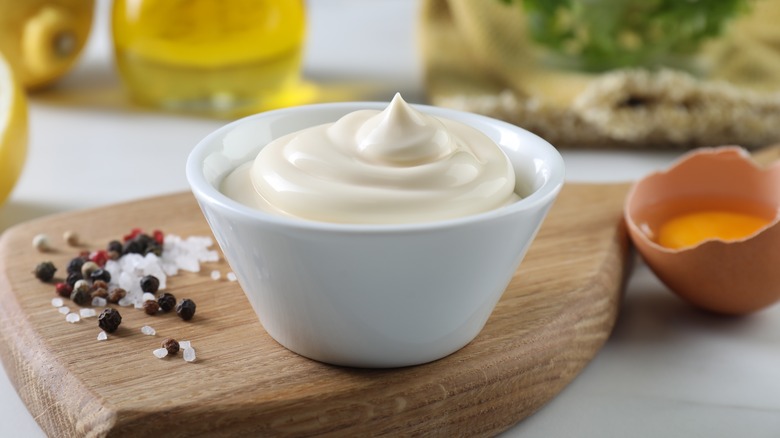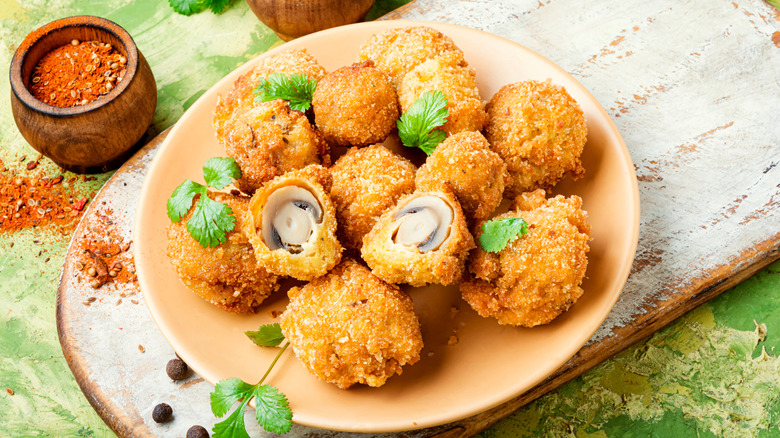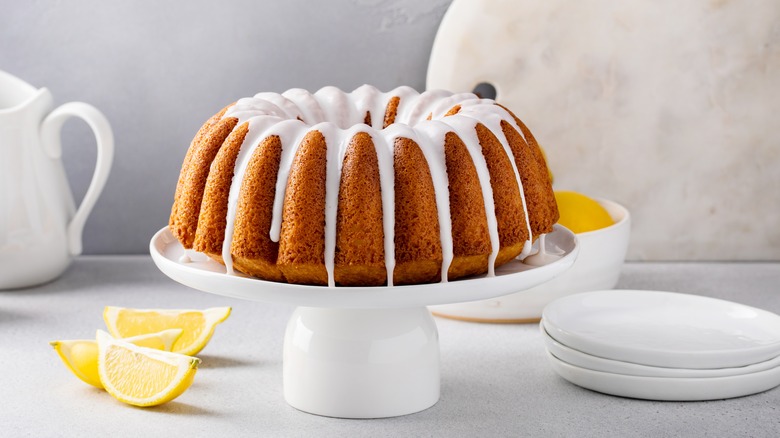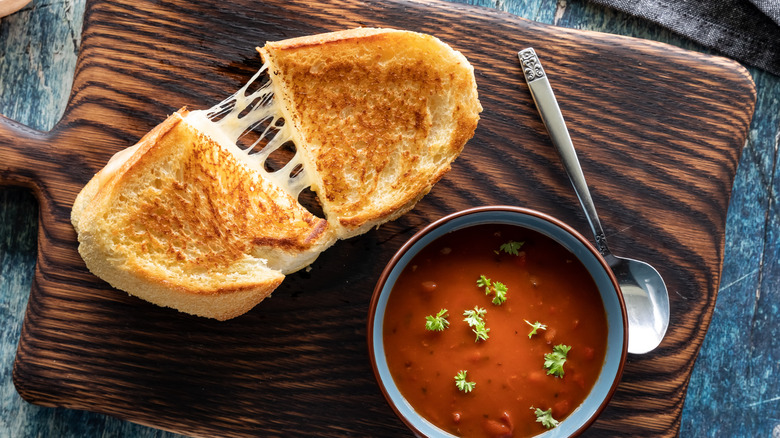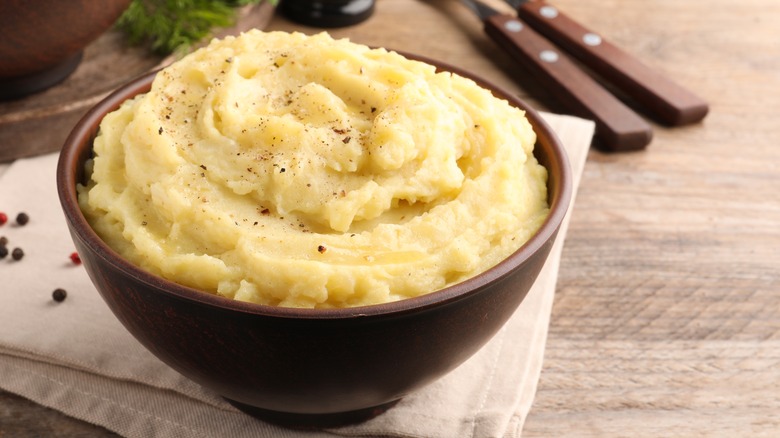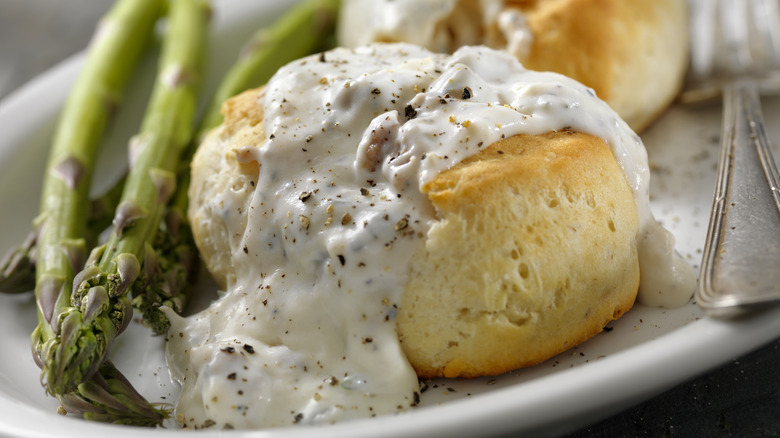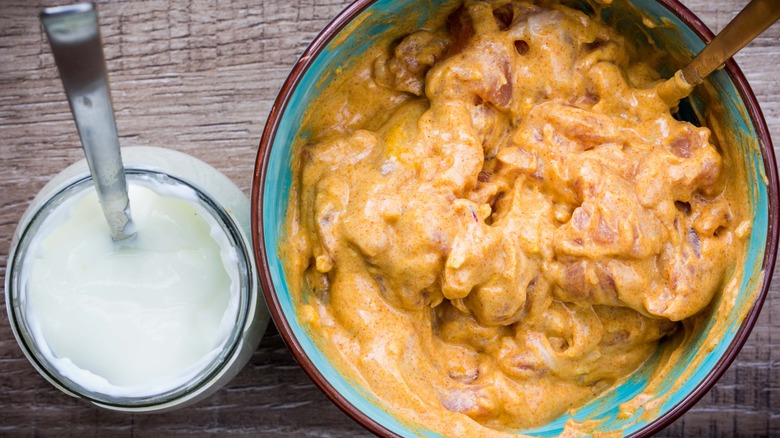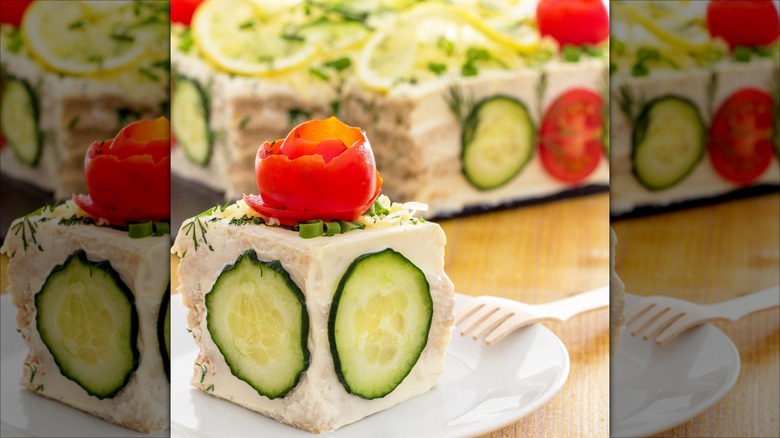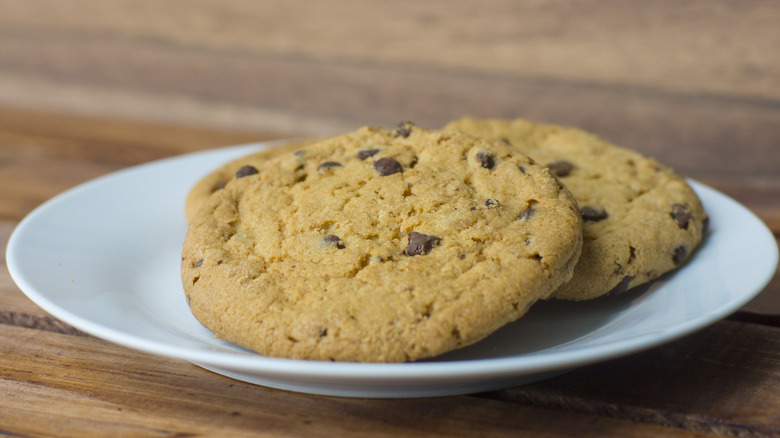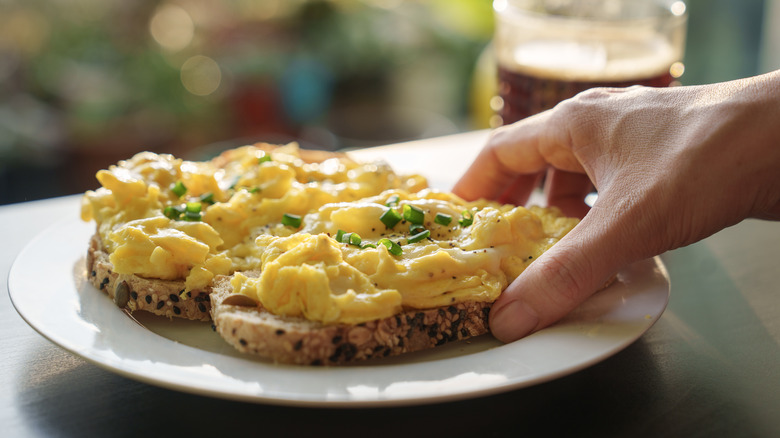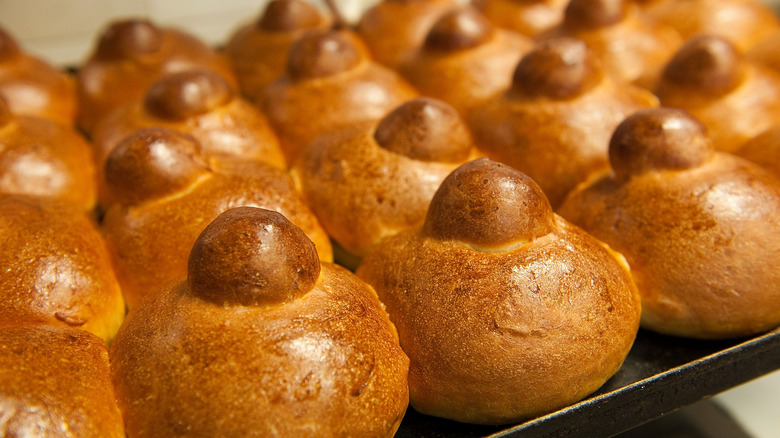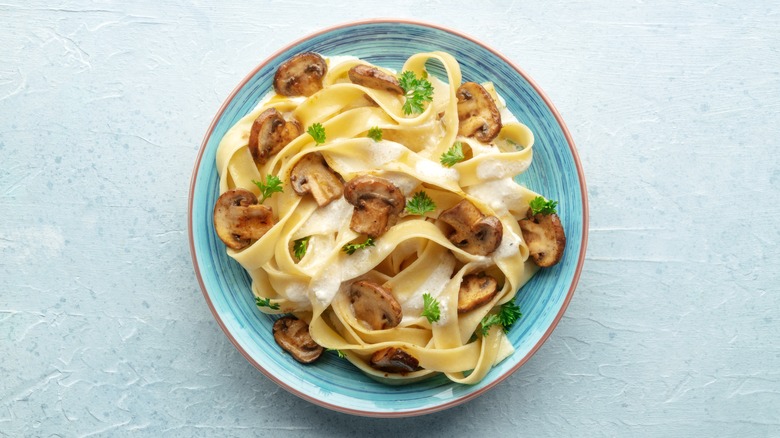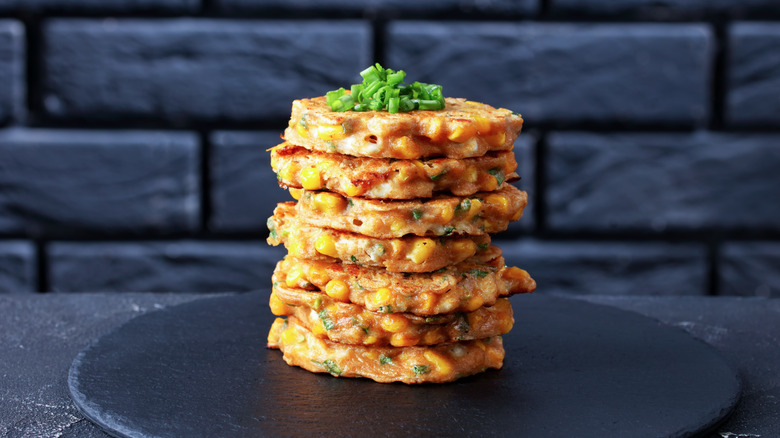12 Unexpected Ways To Use Mayonnaise
You're probably used to spreading mayonnaise on sandwiches or mixing it into potato salad, but you might be at a loss for other things to do with this popular condiment. Or maybe you're not struggling to find ways to use mayo. Perhaps you just love it so much that you want to find some truly off-the-wall ways to incorporate it into your diet. Either way, we're here to help with these 12 unexpected ways to use mayonnaise.
The thing about this spread is that it's incredibly versatile. It's great in certain salads, on burgers, or mixed into dips. But did you know that mayo works as an alternative to egg as a breading substrate? Or that there's a Swedish baked good called a smörgåstårta, which is basically a savory cake with mayo frosting? Well, now you do — and that's just the tip of the iceberg. Don't let convention come between you and fun, creative, and delicious uses for mayonnaise. We'll provide the ideas — you just have to execute them.
1. For breading ingredients
If you're making a recipe that involves breading — such as chicken nuggets or panko-coated mushrooms — you're probably used to dredging whatever you're cooking in egg and flour before moving onto the breadcrumbs. The egg and flour combo acts like a glue to help the breadcrumbs adhere. It's practical, but it involves two steps and it can get messy.
So, this is where mayo comes to the rescue. You can use it instead of egg and flour for breading nuggets, veggies, and so much more. There are various benefits to using mayo as a breading substrate. Firstly, it's easy: You just get your mayo out of the fridge and spoon some into a bowl. There's no need to crack and beat eggs, or measure out flour. Because you're not using flour, it's less messy and you use fewer dishes, which is always a bonus.
It's also easy to get an even layer of mayo, which means the crumbs stick well and stay stuck. This avoids patchy breading. You can also season the mayo before using it, adding salt, pepper, herbs, or spices. This is a simple way of packing extra flavor into your dish.
2. In cakes and muffins
If someone told you that you can add mayonnaise to cakes and muffins, you'd probably give them a hefty dose of the ol' side-eye. It definitely sounds made-up at best and revolting at worst. But we're here to tell you that this actually works. And it tastes good, too!
Mayonnaise is basically just eggs, oil, and lemon juice or vinegar — and all of these are ingredients commonly found in cakes anyway. The eggs and oil add extra moisture to cakes, which makes the crumb tender. Eggs and lemon juice or vinegar help with leavening, so you don't end up with a cake that's overly dense. While you won't taste the lemon or vinegar in the finished cake, it can help to offset excessive sweetness, so you get a balanced bake.
Some recipes use mayonnaise in place of oil or butter and eggs. This is a tactic that dates back to World War II. Since ingredients like eggs and butter were rationed, creative cooks started to use mayonnaise instead, and the rest is history. Other recipes, however, take a more modern approach and use a touch of mayo alongside conventional cake ingredients, such as eggs, butter, and oil. Whichever method you choose, you'll be pleased to know that you won't taste the mayo in the finished cake. It's not such a wacky concept after all.
3. To make crisp grilled cheese
The usual protocol for making a grilled cheese involves buttering the outside of your bread before putting it in the pan. This adds moisture and gives the sandwich a crisp exterior without making it dry. But we're about to throw a spanner in the works: You can also use mayonnaise to make a crisp grilled cheese.
Ultimately, you use it in just the same way you use butter. You spread it on the outside of your bread, then toast the sandwich in the pan. As mayo is mostly made from oil, this gives your grilled cheese a gorgeously fried exterior. The flavor profile is different from butter, but it's still delicious. Plus, it's easier to spread than real butter straight from the fridge, giving you even distribution and cutting down on cooking time.
Some have wondered whether mayonnaise or butter make a better grilled cheese. Well, the jury is still out, and both methods have its fans. If you're not sure which to use, why not try both? There's always the option to add butter to the pan and spread mayo on the bread, giving you the best of both crisp, delicious worlds.
4. Mixed into mashed potatoes
Many of us seek the secret to perfectly creamy mashed potatoes, but few of us get the answer. Well, we're here to help: It might be mayonnaise. Mayo helps give mashed potatoes that silky texture we all crave, as well as a pleasant tang.
If you're thinking that the mayo might replace the milk and butter found in mashed potatoes, you're wrong. You still want the texture and flavor that comes from those essential ingredients. The mayo is added on top of that to kick things up a notch. It presents no problem for mayo-haters, either — while the condiment adds a little zing from the lemon or vinegar, it doesn't make the spuds taste like mayo. We suggest you don't even disclose this ingredient to the nay-sayers — they'll never know.
Mayo in mashed potatoes also helps the potatoes maintain their creamy texture, even when you make them ahead of time. This classic dish can seize up and start to harden when left in the fridge, and it can't always be saved by reheating. Somehow, adding mayo prevents this from happening, allowing you to make your potatoes ahead of time without worrying about them seizing up. This is great news for Thanksgiving and other busy holiday meals.
5. In fluffy biscuit recipes
Biscuits are another seemingly simple recipe where the perfect result can be elusive. People are chiefly concerned with making their biscuits as fluffy as possible. If this is you, we have good news: Adding mayo to your biscuit recipe can give you what you've been craving.
Biscuit recipes made using mayonnaise tend to be extremely light and fluffy. If you're trying to make flaky biscuits, you might want to give this added ingredient a miss. But those who want fluffiness should be using mayo every time. The true beauty of mayonnaise biscuit recipes is that they tend to have very few ingredients. Some just call for milk, mayo, and self-rising flour (or all-purpose flour and raising agents). This means you're likely to always have biscuit ingredients ready to go.
Mayonnaise is also the secret to more tangy biscuits. The lemon juice or vinegar in the mayonnaise adds some zesty brightness. This can give you a similar result and flavor as using buttermilk in biscuits. If you're looking for that down-home tang but don't want to go to the store, you probably already have the answer in your fridge or pantry.
6. Turned into a marinade
Mayonnaise as a marinade? It sounds a little odd, but it's actually an amazing idea for a range of reasons. First off, mayo already adds flavor on its own. It has a richness from the egg yolks and an acidic tang, which suits pretty much everything. Yet it's also neutral enough that you can build off it towards basically any flavor profile. If you want an herby, Italian-inspired marinade, you could add garlic, fresh or dried basil, oregano, olive oil, and a big squeeze of lemon. Or, if you want something Tex-Mex inspired, add cayenne, smoked paprika, and cumin. Using mayo as a marinade also helps with food browning and locks in moisture. Whatever you're marinating will end up moist and tender with a perfectly browned crust, whether you're frying, searing, grilling, or baking.
Although you could slather ingredients in mayo alone, you'll probably want to add more to the mix. It's a good idea to add another condiment for flavor and color. You could choose something like fiery gochujang or tangy Dijon mustard for a punch of deliciousness. Broth, soy sauce, oil, or even water will give it a runnier consistency that more easily penetrates the ingredient you're marinating. Adding an allium — such as garlic, onion, shallots, or scallions — brings zingy flavor, while something acidic brightens the mix.
7. To frost a savory cake known as smörgåstårta
One very unexpected way to use mayonnaise, for those not familiar with Swedish food, is in a smörgåstårta. This Swedish dish is sometimes called a sandwich cake. But unlike a sandwich cookie, it's not a sweet dish. Rather, it's something that looks like a cake but tastes like a sandwich.
You might have seen this showstopper dish on "The Great British Baking Show" – and in truth, you might have been a bit grossed out. But there's nothing wrong with it. In fact, smörgåstårtas can be extremely delicious. You just have to adjust your expectations. Rather than expecting something that tastes cakelike, think of it as a mayo-heavy giga-sandwich and it all makes more sense.
A smörgåstårta can be made with slices of any white bread, but it's even more delicious if you've baked it yourself or bought a high-end bakery loaf. A variety of creamy fillings lie between the bread layers, but one thing they often have in common is the addition of mayonnaise. It may be mixed with other creamy ingredients, such as cream cheese or crème fraiche, or it might be present on its own. The creamy ingredients are mixed with things such as avocado, seafood, cucumber, and fresh dill to make flavorful fillings. Then, the exterior of the cake is frosted with a mixture containing mayo. Decorations, like cherry tomatoes and sliced cucumbers, provide the finishing touch.
8. In cookies
As we've already discovered, mayo makes a good alternative to butter in some baking recipes, because it's essentially just oil and eggs. But it's not just cakes that can benefit from this unexpected ingredient. It can also work in some cookie recipes as well.
Mayo blends seamlessly into doughs and batters, making it easy to work with. You get some binding and leavening properties from the eggs, while the oil provides the fat in the recipe, making cookies moist and tender. Some people even make a three-ingredient shortbread recipe that uses mayo instead of butter. It won't give you quite the same crumbly texture, but it works in a pinch. Plus, it gives some zestiness to the finished cookies due to the acidic ingredients. But we wouldn't recommend just throwing some of this popular spread into any cookie recipe, unless you know what you're doing. Start by experimenting with an existing recipe from someone who's made mayo-containing cookies before.
9. Whisked into scrambled eggs
If you like your scrambled eggs soft and fluffy, you generally have to spend a long time cooking them over low heat or use a cornstarch slurry, which can get messy and time consuming. However, there is another route to perfectly soft scrambled eggs. And, you guessed it, that route goes through mayonnaise town.
All you need to do is add a tablespoon of mayo per two eggs, then season and cook your eggs as usual. It takes about a quarter of the time it generally takes to cook soft scrambled eggs the low way, while still giving you the fluffiness you desire. You don't need to mess around with any unusual techniques — just add the white stuff and away you go.
Adding mayo to scrambled eggs is a technique approved by Alton Brown. The cookbook author and "Good Eats" host says that it gives them a smoother, creamier texture. So you can rest assured that this is an expert-approved tip — and one that's super simple to pull off. There's really no good reason not to try putting mayo in your scrambled eggs.
10. Added to bread recipes
You can add mayonnaise to a range of bread recipes for different purposes. It's a particularly inspired ingredient in brioche. Brioche is an enriched bread, which means it contains eggs and often milk. Mayonnaise just adds to the bread's luxurious taste and texture — though, as long as the ratios are right, you won't taste it in the finished bread. You'll merely notice an enhanced level of sweetness and richness.
You can also use mayonnaise in dinner roll recipes. Here, mayo is used alongside baking powder and self-rising flour to make quick rolls without yeast. This means you can get rolls on the table in 30 minutes or so, with no need to wait for the dough to rise. The mayo also creates a lusciously fluffy texture. Mayo can be similarly used in more conventional loaves of sandwich bread. With this kind of recipe, it adds more moisture to the dough. The eggs help to bind the ingredients and the oil improves the texture. It may also help in gluten-free baking, where eggs are often relied upon for binding and leavening, to avoid a dense or crumbly loaf.
11. In Alfredo sauce
Alfredo sauce is usually made with heavy cream. However, the original version of this sauce had no cream in it at all, so there's definitely license to get creative here. If you're craving a creamy pasta and you don't have any cream to hand, you can take a shortcut by simply using mayonnaise.
What makes mayo great in sauces like this is that it's a stable emulsion. This means it's unlikely to separate. It also has some tang to it from the acidic ingredients, which cuts through the usual richness and creaminess of an Alfredo sauce. There are different ways to use this spread in an Alfredo sauce: Some replace the cream entirely with mayo, while others combine it with milk and cheese for a smooth, rich sauce. Both work beautifully.
If you want to mix things up a bit, you can add some sautéed veggies to your mayonnaise Alfredo. These can be anything of your choosing, but especially nice additions include bell peppers, zucchini, and broccoli. Added vegetables can help to cover any differences in flavor between this version of Alfredo sauce and the standard take.
12. As a binder
A binder is something that holds ingredients together in various recipes. Egg is one of the most common binders, often used in dishes such as meatloaf or sweet corn fritters. Due to the egg in mayo, you can easily use it as an alternative binder in these kinds of recipes.
What we love about using mayonnaise instead of egg is how simple the whole process is. Instead of cracking an egg, making sure not to leave behind any shell, whisking it, then using it in your recipe, you just spoon a little mayo into your other ingredients, and voila — you're done. It could hardly get more simple, and you've probably already got some in your fridge.
One of the other things that makes mayo appealing as a binder is that it has a neutral flavor. It doesn't leave behind a discernible taste, so it won't affect the flavor profile of whatever you're making. Plus, it can help with browning, which is great in recipes where you want a crispy golden crust. And let's be real — this is pretty much always the result you want, no matter what you're making.
